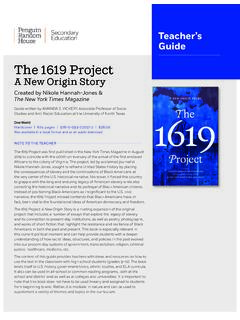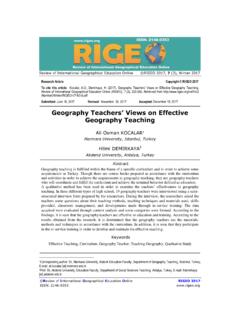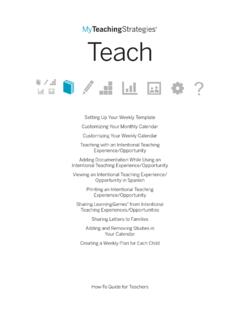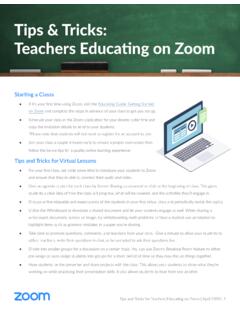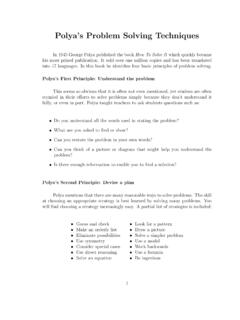Transcription of Antiracist Baby Learning Guide - Penguin Random House
1 A Learning Guide to Antiracist baby . Art by Ashley Lukashevsky Dear Caregivers, Thank you for picking up this book; we're excited to Guide you through some conversations and activities for you and your child. We are #DisruptTexts, a group of four women of color educators Tricia Ebarvia, Lorena Germ n, Kim Parker, and Julia E. Torres who have come together to push our nation to disrupt the traditional literary canon and argue for a more inclusive, representative, and equitable language arts curriculum and pedagogy that our students deserve. As educators and mothers, we are well aware of the important role caregivers make in our young children's education. Our caregivers are our first teachers, shaping how we understand ourselves, others, and the world.
2 We believe in your power and are here to support you. One of the pillars of #DisruptTexts is to continuously interrogate your own biases. We know, both from current events and from long-standing social injustices, that racism has not gone away. It has only evolved. It's the water we all swim in. Thus, we must do personal, internal work so that we stop perpetuating this system. In his adult book How to Be an Antiracist , Dr. Kendi argues that we are either racist or Antiracist ; there is no in-between. Because research has shown that babies as young as six months old show racial preferences, Learning to be Antiracist is work that even our youngest of children can and must do. Antiracism goes beyond universal platitudes to be kind.
3 Being kind does not mean we avoid seeing race, but that we celebrate racial differences. Furthermore, although we might teach our children that anyone can do anything, we must also teach them that racist barriers exist that stop us all from being truly free and that we have the power to change this. We believe that with Antiracist baby , caregivers and children together can begin the process of understanding racial identity. The only way to remove the stigma and shame around talking about race is to normalize these conversations. If you want to be successful, however, you have to do the work on yourself, first, and hope you will find some helpful suggestions in this Guide . It is in your power to raise the Antiracist children our world needs.
4 You can do this. We must do this. Questions for consideration 1. How have you been socialized to understand your own racial identity? Antiracist parenting begins with yourself. First, identify the external and internal forces that shape your way of thinking about your own racial identity, including language you use (or don't use) to talk about race, racism, and antiracism. What beliefs or feelings do you associate with talking about race and where do these come from? How have your experiences helped you or limited your understanding of your racial identity, and what can you do to address this? To White caregivers: In the Teaching Tolerance article White Anti-Racism: Living the Legacy, Sejal Patel describes the stages of what it means to get it or become a successful ally to People of Color.
5 Racism is a problem that was invented by White people, and it is the work of White people to dismantle it. As such, we invite White caregivers seeking to be Antiracist to study Whiteness, including the work of Robin DiAngelo, Debby Irving, and Tim Wise. 2. How have you been socialized to understand the racial identities of others? Interrogate your understanding of people of different races from your own. Ask yourself: In what ways have racial stereotypes affected my own thinking and how? Consider language: How have the words you have been taught informed your thinking of other racial groups? For example, Indigenous, Black, and People of Color are not minorities but People of the Global Majority (PGM) (Montessori for Social Justice).
6 Reflect on your sources of knowledge: How have you been socialized to see knowledge and wisdom belonging mostly (or only) to Western European society? How can you broaden your appreciation of the contributions of PGM to include writing, science, art, etc. so you can share them with your family? 3. How well do you understand how racism functions in the policies and practices in your everyday life? A key part of being Antiracist is understanding that racist policies are the problem, not people. The more you deepen your understanding of structural racism, the more you will be able to see how these racist policies are reflected in your everyday life . and the more you will be able to point these out to your children in ways they can begin to understand.
7 For example, you might live in a segregated neighborhood or attend segregated schools. Unless this is explicitly identified as a racist policy, then children might assume that this segregation is acceptable. (To learn more, we recommend The Race Forward series from Colorlines on What is systemic racism? ). 4. How can I develop my language around race, racism, and antiracism? The second principle in Antiracist baby says to use your words to talk about race. Be sure you yourself have a range of descriptive, positive words to identify race and normalize discussions about race to remove the stigma around it. Furthermore, because race is a social construct, the words we use to talk about race change.
8 As you continue your own Learning , pay attention to the words and terms that critical race scholars and communities of color use and why. Questions for consideration Sometimes the hardest part of committing to racial justice is getting started. Now that you've started on your own journey of becoming an Antiracist , though, and have read Antiracist baby with your families, we hope you will continue moving toward creating the Antiracist world our children deserve. Because we understand progress comes from repeated, continual action, we leave you with a few suggestions for next steps you can take in your efforts to raise Antiracist children. 1. Using Antiracist baby as a foundation, curate a diverse library with your child to affirm positive racial identity development.
9 This means auditing your current collection carefully: In what ways are your books inclusive of a variety of writers, characters, and stories? How diverse are the stories: Do they show the full range of experiences within and across racial groups? We recommend prioritizing books by authors writing from an authentic, cultural insider perspective. Support Black-and brown-owned bookstores. To find additional titles, we recommend websites such as , , , and 2. You might make a mistake in these conversations with your children. It happens often and it is common. The best way to address that mistake is to do your own research to figure out what the correction is. Once you have the information, invite your child to a follow-up conversation.
10 You may begin by saying, I made a mistake when I explained -----, but now I. have learned that it's actually -----. Do you forgive my mistake? Let's learn together about ----.. Praise for Antiracist baby . [Kendi's] succinct, impactful prose makes for an accessible Guide to anti-racism for everyone.. School Library Journal, starred review ABOUT THE CREATORS. Ibram X. Kendi is a #1 New York Times bestselling author, professor of history and international studies, and the Director of the Boston University Center for Antiracist Research. He is an Ideas Columnist at The Atlantic, and a correspondent with CBS News. He is the author of four books including Stamped from the Beginning: The Definitive History of Racist Ideas in America, which won National Book Award for Nonfiction, and the New York Times bestsellers How to Be an Antiracist and STAMPED: Racism, Antiracism, and You, co-authored with Jason Reynolds.





